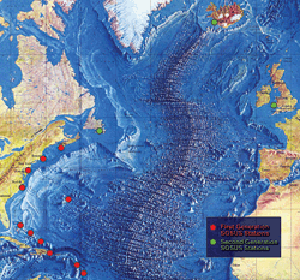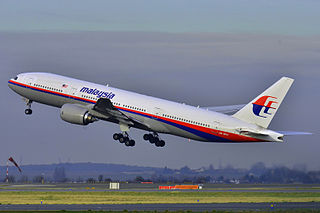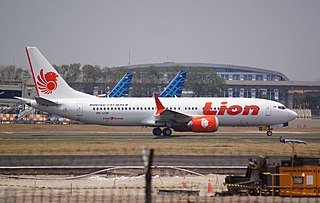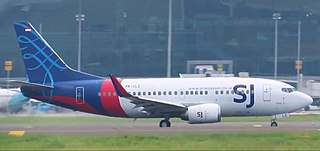
The Sound Surveillance System (SOSUS) was a submarine detection system based on passive sonar developed by the United States Navy to track Soviet submarines. The system's true nature was classified with the name and acronym SOSUS themselves classified. The unclassified name Project Caesar was used to cover the installation of the system and a cover story developed regarding the shore stations, identified only as a Naval Facility (NAVFAC), being for oceanographic research. In 1985, as the fixed bottom arrays were supplemented by the mobile Surveillance Towed Array Sensor System (SURTASS) and other new systems were coming on line, the name itself changed to Integrated Undersea Surveillance System (IUSS). The commands and personnel were covered by the "oceanographic" term until 1991 when the mission was declassified. As a result, the commands, Oceanographic System Atlantic and Oceanographic System Pacific became Undersea Surveillance Atlantic and Undersea Surveillance Pacific, and personnel were able to wear insignia reflecting the mission.

USS Kidd (DDG-100) is an Arleigh Burke-class destroyer in the United States Navy. She is the third Navy ship named after Rear Admiral Isaac C. Kidd, who was on board Arizona during the attack on Pearl Harbor, and was the first American flag officer to die in World War II. The ship is part of Destroyer Squadron 1 of Carrier Strike Group 1 which is currently headed by the Nimitz-class nuclear-powered aircraft carrier USS Carl Vinson (CVN-70).

Mary Sears was a Commander in the United States Naval Reserve and an oceanographer at the Woods Hole Oceanographic Institution (WHOI).

The Pathfinder-class survey ships are owned by the United States Navy and operated by Military Sealift Command for the Naval Oceanographic Office ("NAVOCEANO"). They have mostly civilian crews, including scientists from NAVOCEANO.

Adam Air Flight 574 was a scheduled domestic passenger flight operated by Adam Air between the Indonesian cities of Surabaya and Manado that crashed into the Makassar Strait near Polewali in Sulawesi on 1 January 2007. All 102 people on board died, making it the deadliest aviation accident involving a Boeing 737-400. A national investigation was launched into the disaster. The final report, released on 25 March 2008, concluded that the pilots lost control of the aircraft after they became preoccupied with troubleshooting the inertial navigation system and inadvertently disconnected the autopilot. Despite a series of safety incidents, which contributed to the shut down of Adam Air in June 2008, this was the only incident resulting in fatalities during the airline's 5-year existence.

The Bung Tomo class is a class of three Indonesian multi role patrol corvettes or Multirole Light Frigates (MRLF) by Indonesia. They were originally built for the Royal Brunei Navy and named Nakhoda Ragam-class corvettes but were ultimately bought by Indonesia and renamed. The class is named after Bung Tomo, a noted leader of Indonesia's independence movement.

USS Rockaway (AVP-29), later AG-123, was a United States Navy Barnegat-class seaplane tender in commission from 1943 to 1946. She served in both the Atlantic Ocean and the Pacific Ocean during World War II. In 1948, she was loaned to the United States Coast Guard, in which she served as the cutter USCGC Rockaway (WAVP-377), later WAGO-377, WHEC-377, and WOLE-377, from 1949 to 1972.

Merpati Nusantara Airlines Flight 9760D was a domestic commercial passenger 50-minutes flight, flying from Sentani Airport in Papua's Province Jayapura to Oksibil Airport in Oksibil, Indonesia operated by a de Havilland Canada DHC-6 Twin Otter 300. On Sunday, August 2, 2009, while carrying fifteen people over Papua, the aircraft went missing en route. Its wreckage was found a few miles from Oksibil two days later. All 12 passengers and 3 crew members were killed in the accident.

Nusantara Buana Air Flight 823 was a non-scheduled domestic passenger flight operated by a CASA C-212 Aviocar from Medan to Kutacane, Indonesia, that on 29 September 2011 crashed in the jungle, killing all eighteen people on board.

On 9 May 2012, a Sukhoi Superjet 100 airliner on a demonstration tour in Indonesia crashed into Mount Salak, in the province of West Java. All 37 passengers and 8 crew on board were killed. The plane had taken off minutes before from Jakarta's Halim Airport on a promotional flight for the recently launched jet, and was carrying Sukhoi personnel and representatives of various local airlines.

Malaysia Airlines Flight 370 (MH370/MAS370) was an international passenger flight operated by Malaysia Airlines that disappeared on 8 March 2014 while flying from Kuala Lumpur International Airport in Malaysia to its planned destination, Beijing Capital International Airport in China. The crew of the Boeing 777-200ER, registered as 9M-MRO, last communicated with air traffic control (ATC) around 38 minutes after takeoff when the flight was over the South China Sea. The aircraft was lost from ATC’s secondary surveillance radar screens minutes later, but was tracked by the Malaysian military’s primary radar system for another hour, deviating westward from its planned flight path, crossing the Malay Peninsula and Andaman Sea. It left radar range 200 nautical miles northwest of Penang Island in northwestern Peninsular Malaysia.

The disappearance on 8 March 2014 of Malaysia Airlines Flight 370, a scheduled international passenger flight from Kuala Lumpur International Airport to Beijing Capital International Airport, prompted a large, multinational search in Asia and the southern Indian Ocean that became the most expensive search in aviation history. Analysis of communications between the aircraft and Inmarsat by multiple agencies has concluded that the flight ended in the southern Indian Ocean.

The timeline of Malaysia Airlines Flight 370 lists events associated with the disappearance of Malaysia Airlines Flight 370—a scheduled, commercial flight operated by Malaysia Airlines from Kuala Lumpur International Airport to Beijing Capital International Airport on 8 March 2014 with 227 passengers and 12 crew. Air traffic control lost contact with Flight 370 less than an hour into the flight, after which it was tracked by military radar crossing the Malay Peninsula and was last located over the Andaman Sea. Analysis of automated communications between the aircraft and a satellite communications network has determined that the aircraft flew into the southern Indian Ocean, before communication ended shortly after 08:19 (UTC+8:00). The disappearance initiated a multi-national search effort that became the most expensive search in aviation history.

Indonesia AirAsia Flight 8501 was a scheduled international passenger flight operated by Indonesia AirAsia from Surabaya, Java, Indonesia, to Singapore. On 28 December 2014, the Airbus A320 flying the route crashed into the Java Sea, killing all 162 people on board. When search operations ended in March 2015, only 116 bodies had been recovered. This was the third-deadliest aviation accident in Indonesian soil, behind Garuda Indonesia Flight 152 and Lion Air Flight 610. It is also the first fatal crash of an Airbus A320 aircraft since the crash of XL Airways Germany Flight 888T in 2008, as well as the second deadliest involving the Airbus A320 family, behind TAM Airlines Flight 3054 in 2007.

EgyptAir Flight 804 was a regularly scheduled international passenger flight from Paris Charles de Gaulle Airport to Cairo International Airport, operated by EgyptAir. On 19 May 2016 at 02:33 Egypt Standard Time (UTC+2), the Airbus A320 crashed into the Mediterranean Sea, killing all 56 passengers, 3 security personnel, and 7 crew members on board.

INS Sandhayak (J18)(Hindi: संधायक lit. coordinator) was the lead ship of the Sandhayak class of survey ships. The ship operates as a hydrographic survey ship in the Indian Navy, under the Eastern Naval Command. Apart from a helicopter and Bofors 40 mm gun for self defence, the ship is also equipped with four survey motor boats, two small boats. The ship can also analyse the level of pollution, sea level at various places, sea bed and marine wealth. Sandhayak is capable of conducting shallow coastal and deep oceanic hydrographic survey and collect oceanographic and geophysical data. The ship was decommissioned on 4 June 2021 after 40 years in service.

Lion Air Flight 610 (JT610/LNI610) was a scheduled domestic passenger flight from Soekarno–Hatta International Airport, Jakarta to Depati Amir Airport, Pangkal Pinang in Indonesia. On 29 October 2018, the Boeing 737 MAX operating the route crashed into the Java Sea 13 minutes after takeoff, killing all 189 passengers and crew. It was the first major accident involving the new Boeing 737 MAX series of aircraft, introduced in 2017, and the highest death toll of any accident or incident involving a 737 series aircraft, surpassing Air India Express Flight 812 in 2010. It was the deadliest accident in Lion Air's history, surpassing the 2004 Lion Air Flight 538 that killed 25, and the second deadliest aircraft accident in Indonesia behind Garuda Indonesia Flight 152.

The Cakra class is a class of two Type 209/1300 attack submarines developed by Howaldtswerke-Deutsche Werft of Germany that were bought and commissioned by the Indonesian Navy in the 1980s. The second member of the class, KRI Nanggala sank in 2021 with all hands during an exercise. The lead submarine, KRI Cakra, remains in service.

Sriwijaya Air Flight 182 was a scheduled domestic passenger flight from Jakarta to Pontianak, Indonesia. Five minutes after departing from Soekarno–Hatta International Airport on 9 January 2021, the Boeing 737-500 experienced an upset and crashed into the Java Sea off the Thousand Islands, killing all 62 people on board. A search of the area recovered wreckage, human remains, and items of clothing. The flight data recorder (FDR) was recovered on 12 January, and the data storage module of the cockpit voice recorder was recovered on 30 March.

KRI Nanggala (402), also known as Nanggala II, was one of two Cakra-class Type 209/1300 diesel-electric attack submarines of the Indonesian Navy.



















